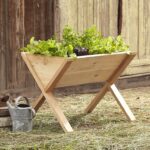Are you looking for tree landscaping ideas to enhance the beauty of your outdoor space? Trees not only add aesthetic appeal to a landscape but also provide numerous benefits such as shade, privacy, and environmental sustainability.
In this article, we will explore the various aspects of tree landscaping, from choosing the right trees for your climate to creative pruning techniques and incorporating trees into different garden designs. Whether you’re a seasoned gardener or just starting out, these ideas will inspire you to create a stunning and functional tree-filled landscape.
When it comes to tree landscaping, choosing the right trees for your specific environment is crucial. Factors such as climate, soil type, and maintenance requirements should all be considered before making any decisions. Furthermore, understanding how to properly place and arrange trees in your landscape can create a visually appealing and balanced outdoor space.
In addition to aesthetics and placement, proper care and maintenance are vital for keeping your trees healthy and thriving all year round. Additionally, using trees strategically can serve functional purposes such as providing shade, creating privacy screens, or even establishing outdoor living spaces. Join us as we delve into the world of tree landscaping and discover the endless possibilities that come with incorporating trees into your outdoor design.
Choosing the Right Trees for Your Landscape
When it comes to tree landscaping ideas, choosing the right trees for your landscape is crucial for a successful and sustainable design. There are several factors to consider when selecting trees, including climate, soil type, and maintenance requirements. Understanding these factors will help you make informed decisions that will result in a visually appealing and thriving landscape.
Climate is one of the most important considerations when choosing trees for your landscape. Different tree species have specific climate requirements, so it’s essential to select trees that are well-suited to the temperature range and weather conditions in your area. For example, if you live in a region with hot summers and cold winters, you’ll want to choose trees that are tolerant of these temperature extremes.
In addition to climate considerations, it’s also important to assess the soil type in your landscape. Some trees prefer well-drained soils, while others thrive in clay or loamy soils. Conducting a soil test can help you determine the pH level and nutrient content of your soil, which will guide you in selecting trees that are best suited to your specific soil conditions.
Lastly, maintenance requirements should also be taken into account when choosing trees for your landscape. Some trees require regular pruning and shaping, while others are low-maintenance and only need occasional care. By considering these factors, you can ensure that the trees in your landscape not only look beautiful but also remain healthy and easy to care for.
| Factors | Considerations |
|---|---|
| Climate | Temperature range and weather conditions |
| Soil type | Well-drained soils or clay/loamy soils |
| Maintenance requirements | Regular pruning & shaping or low-maintenance care |
Tree Placement and Arrangement
Consideration of Tree Size and Shape
When planning the placement of trees in your landscape, it’s important to consider the size and shape of the tree at maturity. This will help prevent overcrowding and ensure that each tree has enough space to grow and flourish. Additionally, varying the heights and shapes of trees can add visual interest to your landscape.
Creating Focal Points
Strategic placement of trees can create focal points within your landscape design. By placing a specimen tree in a prominent position, such as near an entryway or at the center of a garden bed, you can draw attention to its beauty while adding depth to the overall composition.
Grouping Trees for Impact
Grouping trees together can create a strong visual impact in your landscape. Consider planting trees in clusters or in irregular patterns to create a more natural look. This approach can also help fill empty spaces while adding diversity to your outdoor space.
By carefully considering tree placement and arrangement, you can maximize the beauty and functionality of your landscape. Whether you’re aiming to create a serene garden retreat or a lively outdoor living area, incorporating these tree landscaping ideas into your design will help you achieve a visually stunning and balanced landscape.
Creative Pruning and Trimming Techniques
Pruning for Aesthetic Appeal
One popular technique for enhancing the aesthetic appeal of trees is crown reduction pruning. This involves selectively removing branches to reduce the size of the tree’s canopy, resulting in a more attractive shape and balanced appearance. Additionally, selective thinning can be used to improve airflow and allow more sunlight to reach the lower branches, creating a healthier and more visually appealing tree.
Trimming for Health
Regular trimming is important for maintaining the health of your trees. Removing dead or diseased branches not only improves the tree’s appearance but also prevents potential hazards such as falling limbs. Proper trimming also promotes new growth and can help prevent insect infestations and diseases from spreading throughout the tree.
Incorporating creative pruning and trimming techniques into your tree landscaping design can elevate the beauty and functionality of your outdoor space. Whether you are looking to enhance the visual appeal or promote the health of your trees, these techniques are essential for creating a well-maintained landscape that will be enjoyed for years to come.
Tree-Themed Garden Designs
When it comes to tree landscaping ideas, incorporating trees into various garden styles can add a unique and distinctive touch to your outdoor space. Whether you’re aiming for a Zen-inspired Japanese garden, a lush and colorful Mediterranean garden, or a tropical paradise, there are endless possibilities for creating a stunning tree-themed garden design.
In a Japanese garden, trees play a crucial role in creating a harmonious and tranquil atmosphere. Consider incorporating elegant and graceful trees such as Japanese maple, cherry blossom, or pine trees. These trees not only provide shade and beauty but also symbolize tranquility and balance. To enhance the authenticity of your Japanese garden, arrange the trees in asymmetrical patterns and incorporate elements like bamboo fences, stone lanterns, and water features.
For those looking to create a Mediterranean-style garden, olive trees, citrus trees, and cypress trees are excellent choices. These trees thrive in sunny and dry climates and add an exotic touch to the landscape. Their aromatic foliage and vibrant fruits contribute to the vibrant and welcoming ambiance of a Mediterranean garden. Pair them with fragrant herbs like lavender, rosemary, and sage to complete the sensory experience.
If you’re dreaming of a tropical oasis in your backyard, consider planting palm trees, banana trees, or coconut palms to achieve that lush and vibrant look. These tall and stately trees can instantly transform your outdoor space into a tropical paradise. Add colorful flowers like hibiscus, bougainvillea, and orchids along with other tropical plants to create layers of texture and vibrant colors throughout the garden.
Incorporating these tree-themed garden designs into your landscape can create an inviting outdoor space that reflects your personal style while adding value to your property. Keep in mind the specific climate requirements of each type of tree when selecting which ones to include in your design.
Tree Care and Maintenance
When it comes to tree landscaping ideas, caring for and maintaining your trees is essential to ensure their health and longevity. Proper tree care not only helps them thrive all year round but also enhances the beauty of your landscape. One important tip for tree care and maintenance is regular watering, especially during dry periods. Trees need water to survive, and insufficient watering can lead to stress, disease, and even death.
In addition to watering, proper pruning is crucial for the health of your trees. Pruning helps remove dead or diseased branches, promotes healthy growth, and improves the overall appearance of the tree. When pruning, it’s important to use the right tools and techniques to avoid causing damage to the tree. Hiring a professional arborist for complex pruning jobs can ensure that your trees are properly cared for.
Another vital aspect of tree maintenance is regular inspection for pests and diseases. Keeping an eye out for signs of infestation or illness can help you address issues early on, preventing them from spreading and causing irreversible damage to your trees. Implementing a proactive pest management plan can help protect your trees from harmful insects and diseases.
| Tree Landscaping Tip | Action |
|---|---|
| Regular Watering | Water trees during dry periods |
| Proper Pruning | Remove dead or diseased branches |
| Pest Inspection | Regularly check for signs of infestation and disease |
Functional Tree Landscaping Ideas
When it comes to tree landscaping ideas, functionality is key. Trees can serve practical purposes beyond just adding beauty to your outdoor space. Here are some functional tree landscaping ideas to consider:
1. Shade: One of the most common uses of trees in landscaping is to provide shade. Consider planting large, leafy trees such as maple, oak, or beech in strategic locations in your yard to create shady spots where you can relax or entertain. Not only do these trees offer relief from the sun, but they also add a natural element to your outdoor living areas.
2. Privacy: If you’re looking to create a more secluded and intimate atmosphere in your yard, using trees for privacy is a great option. Consider planting evergreen trees such as arborvitae or leyland cypress along property lines or near patios and decks to create a natural privacy screen. They not only provide seclusion but also act as a sound barrier from noisy neighbors or nearby traffic.
3. Outdoor Living Spaces: Trees can also be used to define and enhance outdoor living spaces. For example, planting flowering trees such as cherry blossoms or magnolias near seating areas can add color and fragrance to the space. You can also incorporate trees into your patio or deck design by building around existing mature trees or using them as support for pergolas or awnings.
Remember that proper maintenance and care are essential for ensuring that your trees continue to serve their functional purposes effectively. Regular pruning, watering, and fertilizing will help keep your trees healthy and thriving so that you can fully enjoy the benefits they bring to your outdoor landscape.
Whether you’re looking for shade, privacy, or ways to enhance your outdoor living spaces, incorporating the right trees into your landscaping plans can make a big impact on both the look and feel of your yard.
Sustainable Tree Landscaping
In today’s world, it is increasingly important for individuals and communities to prioritize sustainable and eco-friendly practices, and tree landscaping offers a unique opportunity to do so. By carefully selecting, planting, and maintaining trees in our landscapes, we can reduce environmental impact while creating beautiful outdoor spaces.
One of the key considerations for sustainable tree landscaping is choosing native or climate-appropriate tree species. By selecting trees that are well-suited to the local climate and soil conditions, you can decrease the need for excessive irrigation, fertilization, and pest control. Additionally, native trees often require less maintenance overall, which reduces the use of chemical inputs and resources.
Another important aspect of sustainable tree landscaping is implementing water conservation practices. When designing your tree landscape, consider incorporating water-efficient irrigation systems such as drip irrigation or smart watering technology. This not only reduces water consumption but also ensures that your trees receive the right amount of hydration without wastage.
Furthermore, sustainable tree landscaping ideas can include using fallen leaves and pruned branches as natural mulch or compost for your garden beds. This practice helps to enrich the soil with organic matter while minimizing waste sent to landfills.
Additionally, choosing natural or organic fertilizers can further reduce environmental impact by avoiding harmful chemicals that may leach into the surrounding environment. By incorporating these eco-friendly practices into your tree landscaping projects, you can create a visually stunning and environmentally conscious outdoor space.
Conclusion
In conclusion, trees are an essential and versatile element in landscaping, offering numerous benefits for both the environment and our well-being. From providing shade and privacy to enhancing the visual appeal of outdoor spaces, trees are truly invaluable. By carefully selecting the right trees for your landscape based on factors such as climate and maintenance needs, you can create a thriving and visually appealing outdoor space that will continue to grow and flourish for years to come.
Moreover, creative pruning and trimming techniques can further enhance the aesthetic appeal of your trees while ensuring their health and longevity. Additionally, incorporating tree-themed garden designs into various styles such as Japanese, Mediterranean, or tropical gardens can add a unique and harmonious touch to your landscape.
It’s important to remember that proper tree care and maintenance are essential for keeping your trees healthy and thriving throughout the year. Furthermore, incorporating sustainable practices into your tree landscaping projects can help reduce environmental impact while creating a beautiful outdoor space. Overall, with the right tree landscaping ideas and a bit of creativity, you can transform your outdoor space into a tranquil and inviting oasis that showcases the natural beauty of trees.
Frequently Asked Questions
What Is the Best Way to Landscape Around Trees?
The best way to landscape around trees is to create a “mulch circle” around the base of the tree. This helps retain moisture, control weeds, and protect the roots from lawnmower damage. It’s important not to pile mulch up against the trunk, as this can lead to rot and disease.
How Do I Landscape My Backyard With Trees?
When landscaping a backyard with trees, consider the size and shape of the trees as well as the overall design aesthetic you’re trying to achieve. Choose complementary plants and hardscaping elements like pathways or seating areas that work well with the existing trees.
Also, make sure to leave enough space for the trees’ root systems to expand without being disturbed.
What Is the Best Material to Put Around a Tree?
The best material to put around a tree is organic mulch, such as wood chips or shredded bark. This type of mulch allows air and water to penetrate down to the roots while preventing weed growth and keeping the soil moist. Avoid using rocks or rubber mulch, as these can hinder water and oxygen exchange for the tree’s roots.

Welcome to my gardening blog! I am passionate about plants and enjoy sharing my knowledge and experiences with others. In this blog, I will write about everything related to gardening, from tips on how to get started to updates on my own garden projects.





